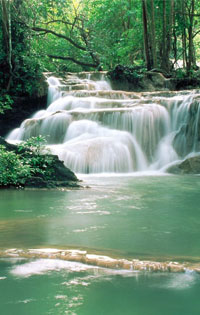Kanchanaburi Travel Guide
 Kanchanaburi is located some 130 kilometers west of Bangkok; travel time is approximately 2 hours by bus. This is the Thailand’s third largest province with an area of 19,486 square kilometers. The provincial area is mostly formed by forested mountains that keep the temperature much cooler than other provinces of Central Thailand. The province has the north-west border next to Myanmar (Burma).
Kanchanaburi is located some 130 kilometers west of Bangkok; travel time is approximately 2 hours by bus. This is the Thailand’s third largest province with an area of 19,486 square kilometers. The provincial area is mostly formed by forested mountains that keep the temperature much cooler than other provinces of Central Thailand. The province has the north-west border next to Myanmar (Burma).
Kanchanaburi city, the capital of Kanchanaburi Province, itself is a popular resort town, it is located around at the confluence of the Kwai Noi and Kwai Yai Rivers (which have their source in the Ta Now Sri Range), these river converge to form the Mae Klong river.
Kanchanaburi was originally established by King Rama I as a first defense line against the Burmese, who might use the old invasion route through the three Pagodas Pass on the Thai-Myanmar border. The present provincial capital is a relatively new town built by King Rama III in 1833. The old town was 18km away.
Kanchanaburi itself captivates scenic beauty in a landscape characterized by easily accessible and spectacular waterfalls, wild jungles, river cruises, Mountain Rivers, tranquil riverside, reservoir settings, national parks, varied wildlife and Neolithic burial grounds, the combination of these elements makes Kanchanaburi an excellent tourist destination for nature lovers. The town itself is a place to relax watching the water slide or inside a raft house. Many visitors like to rest along the river with a cold drink and a good book. Many of them come here just for a couple days but stay for weeks. Visitors discover why Kanchanaburi is one of the most beautiful provinces in the Kingdom of Thailand.
Many of its attractions are connected with the Second World War and more specially the years 1942 to 1945. Kanchanaburi is principally known as the site of the notorious World War II Death Railway to Burma (Myanmar) and the Bridge over the River Kwai, made immortal by the French novelist Pierre Boulle’s book and as the location of the David Lean’s film of the same name, after the film, tourists started to travel to Kanchanaburi to see the location of the bridge. Today, the bridge is still used occasionally by local train traffic.
In 1942, the famous Bridge over the River Kwai was built by Japanese Army, employing Prisoners Of War (POW) and forced-labor Asian coolies as a link in the infamous Death Railway joining Thailand with Burma. Over 80,000 laborers and 13,000 POWs and thousands of Japanese soldiers lost their lives during the construction of this bridge. Once a year, between November and December the River Kwai Bridge Festival is set up in the area next to the bridge with a spectacular Sound & Light show. This event reminds to the history of the Death Railway and the bombing of the bridge.

The way to Kanchanaburi also leads the historic city Nakhon Pathom, capital of the Nakhon Pathom Province which hosts the tallest Buddhist monument of the world. In Kanchanaburi, together with Tak, is located the Thung Yai Naresuan Wildlife Sanctuary, a large jungle area listed as a UNESCO World Heritage Site. The Erawan Waterfalls with its seven levels set inside the Erawan National Park are worth a visit and rank among the most impressive waterfalls in Asia.
Other interesting attractions are the show of the “floating nun” at Wat Tham Mongkon, the Tiger Temple, the Thailand-Burma Railway Museum (opened in March 2003), the JEATH War Museum about the bridge and the Death Railway, the Kanchanaburi War Cemetery where one can find the graves of more than 8 000 POWs who died here, a national museum, a historical park.
Kanchanaburi city also serves as the base for those nature lovers who want to explore the province’s many attractions; here visitors can find adequate transportation means, many tourist options and roads in excellent condition. There are many outdoor sport opportunities in Kanchanaburi, since rafting in the wild river, fishing in remote jungle backwater and streams to golf courses. There is the thrilling 200 km drive through newly opened jungle areas to the Thai-Myanmar border to visit ethnic Mon and Karen settlement
Kanchanaburi provides the focal point for memorable holidays for nature lovers who delight in natural surroundings and pleasures without sacrificing basic comforts. The main road, Thanon Saeng Chuto, connects the River Kwai Riverm the train station and the bus station. Kanchanaburi has a great selection of bars, restaurants and guesthouses to choose from, most of them can be found around the Thanon Mae Nam Kwae. But if you want to get in touch with the nature, you can stay overnight over a jungle resorts or a float bungalow on rafts moored off the River Kwai bank. A night spent on a float hotel is an unforgettable experience.
